Tactic TTX650 6-Channel 2.4GHz SLT Computer Transmitter and TR624 6-Ch Receiver Review
Tactic Web site
and
Tower Hobbies Web page for the Tactic TTX650
By Ken Myers
May 2013

Tactic TTX650 in center & TTX440 buddy box on right
Tactic Brand 2.4GHz Radio Systems History:
"The first Tactic brand radio transmitter marketed by Hobbico, Inc., with Secure Link Technology (SLT), appears to be the Tactic TTX440. Its FCC Final Action Date was 03/17/2009 and its FCC ID was IYFTTX440. The FCC Grantee Code for Hobbico, Inc. is IYF.
Like Futaba, Tactic traces its 2.4GHz RC roots back to 2007. Note the copyright date here. The link about SLT technolgy on the Tactic RC site states, "When the first Tactic radios came out in 2007..."
It also states, "Tactic SLT systems 'hop' from channel to channel to channel hundreds of times each second."
and
"Frequency hopping virtually eliminates the possibility of same-channel interference all by itself..."
The FCC shows that Hobbico Inc. had an undetermined 2.4GHz model IYFT4-2400, but it does not note that it is SLT nor Tactic and the date is 10/21/2008.
From an historical perspective, the original Spektrum brand DX6 park flyer radio, with 10 model memory, was introduced in mid-2005 and used direct-sequence spread spectrum (DSSS).
The full-range Spektrum DX6i and appropriate receivers appeared in 2008. It used the DSM2 protocol, which was still a DSSS type.
There is a chart at the Tactic RC Web site that shows the features of the Tactic TTX650 compared to the current Spektrum DX6i using DSM2 and a true FHSS with the DSMX protocol.
I first became aware of the Tactic brand 2.4GHz radio system in the summer of 2011. A student pilot at the Midwest RC Society came to the field with a pusher type, ready-to-fly (RTF), trainer with a Tactic radio system installed. He also had a second Tactic transmitter. The second transmitter allowed the use of the wireless trainer system. The radio itself worked well in the plane and so did the easy to use wireless trainer system.
In February of 2013 I became aware that Tactic had added a 'computer' radio to its lineup. From the advertising, I found its price point very interesting. I read as much as I could about it online.
I first held a Tactic TTX650 while visiting Joe Hass. Then, at the Toledo RC Expo, I pointed out some of its features to my flying buddy, Dave Stacer.
On April 23, Joe Hass put me into contact with Carol Pesch, of Hobbico Inc., regarding their Share the Fun program for the Tactic TTX650. On April 25, Carol let me know that they were sending me the Tactic TTX650 6-Channel 2.4GHz SLT Computer Transmitter and a TR624 6-Ch Receiver.
The transmitter and receiver arrived on the evening of May 9, 2013.
I've had two 2.4GHz radio systems since they came on the scene. I gave one away. It did not have the features that I used most, and it did not use true frequency hopping spread spectrum technology. The other is my current Hitec Optic 6 with the 2.4GHz module.
Since there is already a comparison chart for the TTX650 and Spektrum DX6i, many of my comments are comparing the new Tactic TTX650 to my Hitec Optic 6. Unfortunately, the Optic 6 has been replaced by the Optic 6 Sport. The Hitec Optic 6 Sport version no longer has the features that I desire in a 6-channel radio and I cannot recommend it to anyone.
While awaiting delivery of the system, the manual was downloaded from the Tower Hobbies Web site.
The manual was previewed and read in-depth many times.
Through August 31, 2013, the transmitter with two TR624 receivers is selling for $149.97 through Tower Hobbies. The TR624 6-Ch full range receiver is available for $19.99 or three for $49.98.
Using the typical Tower Hobbies' coupon code and the occasional free shipping means that the transmitter and two receivers could be delivered to the door for $129.97!
The 2.4GHz SLT System
The Tactic 2.4GHz system uses what is known as Frequency Hopping Spread Spectrum (FHSS) technology. The Tactic protocol is known as Secure Link Technology (SLT). Being FHSS does not mean that the Tactic equipment is interchangeable with other systems using FHSS. The protocol, SLT, is what is important.
The Tactic TTX650 transmitter may also be used with Tx-R (transmitter-ready) aircraft using the SLT protocol. Typing Tx-R in the search box on the Tower Hobbies' Web site shows the planes and helicopters branded Flyzone, Great Planes and Heli-Max that are Tx-R.
There is also a Web site with information for the Tx-R aircraft.
At the Nuremberg Toy Fair of 2013, Bing Sheng, a product manager with Hobbico Inc., said, near the end of the video, "SLT technology is an open protocol. That means that we allow partners to use the protocol integrated into their own radio."
Hitec appears to be one of their partners, as it is adding the SLT protocol to their transmitters. The first Hitec transmitter to include the SLT protocol is the new Aurora 9X. Many of the new Hitec transmitters will have the SLT protocol built in.
The onboard component connectors for receivers, servos, switch harnesses and receiver batteries used with the Tactic system are the Futaba 'J' type with the polarity ridge on the opposite side of the connector from the 'black'/negative wire. Universal connectors may also be used. When a universal connector is plugged into the Tactic receiver, the 'black'/negative wire should be to the outside of the receiver socket.
Tactic has its own 4-Channel Micro SLT Receiver, 4-Channel SLT Micro Receiver Board with Servos and ESC, servos, servo extensions, switch harnesses, and various other accessories.
It is important to remember when using the Tactic TTX650, Channels 5 and 6 can be controlled by a non-proportional switch, but that Channels 5 and 6 are fully proportional when mixed to channels 1-4.
Getting to know the Tactic TTX650
The Manual:
The manual is well written with large, legible font and clear diagrams. See the note: Manual mistake regarding the wireless trainer set up.
Once the transmitter was removed from its shipping box, the stick tension was compared to that of the Hitec Optic 6. I prefer the firmer stick tension of the Optic 6, and being accustomed to it, the first thing I did was remove the back from the TTX650 and tighten the stick tension. How to do this is found on pages 7 and 8 of the manual.
Removing the two small screws in the handle required a #0 Phillips screwdriver. Needle nose pliers were used to remove the battery connector for removal of the battery box, and later to reinsert the connector. Adjusting the preinstalled throttle tension ratchet also required a #0 Phillips screwdriver. The preinstalled ratchet spring has a 'V' in to provide a 'click' as the throttle is advanced. A second ratchet is included for helicopter pilots. It can replace the preinstalled ratchet spring. It provides a smooth, 'non-click' advancement on the throttle stick.
After adjusting the stick tension, the back of the transmitter was reinstalled, the battery box holder and its connector reinstalled and the 4 provided AA alkaline batteries installed. The stick length was also adjusted.
Using primary batteries in a transmitter can be a 'good' thing because it can be ready to use anytime, as AA batteries are available almost everywhere. Rechargeable NiCAD or NiMH batteries are an option. There is a built-in charger port for hooking up an optional charger, using Futaba polarity, as explained in the manual. (DC Coaxial Power Plug Type M Radio Shack 274-1669)
A good battery choice would be four Sanyo Eneloop Low Self-Discharge (LSD) AA NiMH rechargeable batteries as a pack.
To try and save some battery power, before beginning the transmitter setup and plane programming, the RF Output was turned OFF.
This did not work out too well. Once the transmitter has been shut off, it automatically reverts to RF OUTPUT ON when it is turned on again. Therefore, the RF OUTPUT cannot be shut off during the System Setup. Entering SYSTEM SETUP requires the power switch to be in the off position and then turned on while holding down the push button ENTER key.
The user name KenMyers was entered during System Setup. The name uses the full eight characters available. The other System Setup entries were left at the defaults; STICK MODE: MODE 2, CONTRAST: 0, BEEP VOL.: 3 AND BATT. ALARM: 4.7V.
There is a discrepancy between the default ALARM voltage of 4.7V preset in the transmitter and 4.8V shown on page 11 of the manual. The manual on page 12 also notes the default as 4.00V for both alkaline and NiCad/NiMH, which is really too low. Voltage is not a good indicator of remaining capacity for alkaline/NiCad/NiMH batteries. Because AA alkaline batteries are 'cheap' and aircraft are 'expensive', a conservative 4.6V or 4.7V for both alkaline and NiCad/NiMH batteries is a good, safe setting.
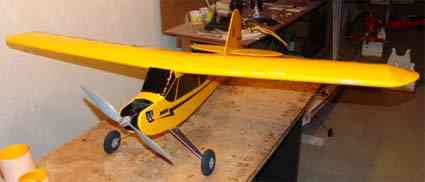
Thunder Tiger Lazy Tiger Cub - club trainer
The only thing changed from the default settings in the MODEL SETUP MENU was the six character name. I used LzyCub for the club trainer, a Thunder Tiger Lazy Tiger Cub. It has about 675 sq.in. of wing area and its ready to fly weight is 63.5 oz./3.97 lb./1.8Kg.
When the throttle servo output, channel 3, is outputting to a stand alone electronic speed control (ESC), as in the LzyCub, it needs to be reversed like on a Futaba transmitter. See the note: Throttle Reversing for an Aircraft ESC
In the SERVO SET menu, channel 3 was set to REV, reverse. Later the elevator and ailerons also needed to be reversed for the LzyCub.
The THROTTLE CUT was set up on switch H so that pulling switch H towards the front of the transmitter inhibits any throttle function. Pushing switch H towards the rear of the transmitter allows the throttle to function. This function is similar to the LOCK button on the Optic 6. It is really an essential function for electrically powered aircraft.
The TIMER menu, was used to set 7:00 minutes for the LzyCub using throttle channel 3 as the 'switch'. It was set up following the directions on page 29.
Linking or Binding
When describing how to get the transmitter to 'talk' only to a specific receiver, Tactic uses both of the words link and bind. The process is called linking by Futaba and Hitec and binding by Spektrum. Tactic interchanges the words in the manual.
To link the measured 8.5g/0.3 oz. Tactic 6-channel TR624 'receiver' to the TTX650, a 4-cell NiMH battery and switch harness was used following the procedure on page 36. It linked very easily by depressing the link button inside the receiver with a tiny, tiny screw driver. Doing the linking outside the aircraft, whenever possible, is much easier. A switch harness is not really necessary but handy. A charged 4-cell NiCad or NiMH pack can be plugged directly into any port connector on the receiver, but Tactic does provide a battery port connector on the receiver. That is a very nice touch.
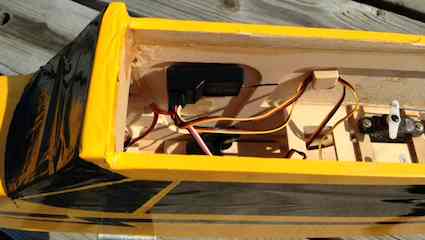
A Tactic TR624 installed in the LzyCub
Bill Baxter, Manager Hobby Services/Futaba Service/North America notes what you should do if you are having a problem linking a Tactic SLT transmitter to a Tactic SLT receiver in post 4 of this thread on RC Universe.
Once the 'receiver' was linked and tested with a servo, the prop was removed from the motor of the LzyCub and the receiver hooked up to the servos and ESC in the plane. Reversing throttle channel 3 was correct. The ailerons and elevator needed to be reversed for this plane. It was very easy to do.
Setting the Failsafe - Don't Omit This Step
The failsafe, that is built into the receiver, shuts the throttle down and holds the other flying surfaces when the signal between the transmitter and receiver is interrupted.
Remove the prop on an electric motor for this step! The failsafe should be set following the directions on p. 37 of the manual, even if it appears to be working on initial setup. Turn on the transmitter and then the receiver. Be sure the throttle is in the lowest position when setting up an electric. Hold down the link button in the receiver and watch for two blinks, one after the other, to indicate that the failsafe has been set. Shut down the receiver and then the transmitter.
Do a failsafe test. There should be NO prop on the plane when the fail safe is tested! Turn on the transmitter and then the receiver. Run up the motor slightly. Also, move a surface, like the elevator, into a position away from neutral. Turn off the transmitter. The motor should shut down and the surface remain in the position it was moved to. Turn the transmitter back on and then shut down the receiver and then the transmitter.
Wireless trainer/buddy box
An older Tactic TTX440 (no I did not mistype the number) was linked to the Tactic TTX650 using the procedure for "Teacher's radio: TTX650 Student's radio: Tactic TTX404 or TTX600" on pages 37 and 38 of the manual. All of the TTX440 servo reversing switches must be in the correct position to match the TTX650 and the plane. See An interesting note about the old TR-424 Receiver
05/11/2013
A second Tactic TR624 receiver was purchased at Flightline Hobby, 1192 S. Lapeer Rd. Lake Orion, MI 48360. It is the very best RC hobby shop in the area and worth the 57 mile round trip!
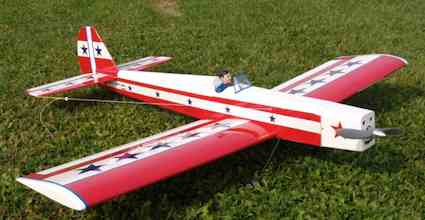
Flite 40 Low-Wing Sport Plane
A second plane, an 87.3 oz./5.46 lb./2.47Kg 645 sq.in. sport low-wing, called the Flight 40 was set up on the transmitter as Flt-40.
The new plane took only a few minutes to bind and set up on the transmitter. That was followed by a check of the failsafe on the bench. Like the Lazy Cub the throttle channel is reversed for the ESC. Again switch H was set to act as a throttle lock when pulled toward the transmitter front and the timer is controlled by the throttle channel.
How long is the range?
I did not do a long distance range test but, Michael Heer did in his review. It is in the section of his review on RC Groups titled "What is the Range?" I suggest you take a look at it. It is very informative. I'll just say here, it is plenty good enough for most of us!
The Proof is in the Flying!
A Tactic TTX650 system got its first workout in the two planes on May 17. Two flights were completed with both planes. The LzyCub uses a Castle Creations Ice 50 with BEC and the Flt-40 uses a 4.8V Sanyo Eneloop receiver pack. Both planes appeared to stay in constant contact and they were both flown out farther and also higher than I normally fly. It looks like this radio is a winner!
Like the smaller LCD on the Hitec Optic 6, the 128 x 64 non-backlighted graphing LCD screen, with adjustable contrast, was easy to read in all light conditions at the field.
Selecting a plane at the field is much easier with the Tactic TTX650, compared to the Hitec Optic 6. The Optic 6 model select screen presents only the number of the model, which can make selecting a specific model a bit tricky if it is not written down. The Tactic TTX 650 shows both the model name and number in the model select menu. After selecting a model in the TTX650 menu, the name of the selected model, as well as its number, appears on the main screen. It takes a couple of clicks of one of the buttons on the Optic 6 to see the model name. The only other time the model name on the Optic 6 is displayed is for a brief moment when the radio is turned on.
Number of flights to date before publication:
LzyCub: 16
Flt-40: 33
Fus380: 10 (See Addendum)
Who could benefit from using this system?
Obviously, the Tactic TTX650, with 20 model memory, would be a great benefit to someone with several Tx-R (transmitter-ready) aircraft.
A newcomer to the hobby should find the price point attractive. The clear and concise manual would make their entry into a programmable 6-channel computer radio much easier than several other other brands.
On a personal note, while I've been flying RC for over 50 years, I've never exceeded the need for a 6-channel radio, although I have had more available on many of the transmitters that I've owned.
Combined with the Tactic TR624 receiver, it has many useful applications for most aircraft modelers.
Many inexpensive radio systems have not been put through the FCC approval process for Part 15 compliance and they do not offer a warranty. Hobbico stands behind Tactic with a 1-year limited warranty in the USA and Canada. Hobbico has a very good reputation in the industry and they want, and go to great lengths, to have satisfied customers.
Possible Improvements and Some Suggestions
Since nothing is ever perfect, here are a few suggestions for some possible improvements.
Use a SD card slot instead of the firmware update plug. With a SD card slot, setups could be shared at the flying field. The SD card could be used to hold more planes in reserve memory and swap planes in and out of the onboard memory.
Route the transmitter antenna in the handle. It could eliminate the awkward, typical 2.4GHz antenna. The case design lends itself to doing it. Futaba is already doing it on two of its transmitters.
Futaba 6J
Futaba 8JA
A note should be added to the manual regarding the fact that most stand alone ESCs require reversing the throttle channel.
A note note added to the manual could mention that setting up discrete receivers is easier on the bench, out of the aircraft and describe how to do it.
A built in port or available 'dongle' for use with RC Flight Simulators could be handy and could allow a link to other brand transmitters for buddy boxing.
Some drawings in the manual could be updated to show the actual defaults as set when the radio is received.
The voltage chart on page 12 could be redone.
The transmitter should provide a warning if the selected model does not match the aircraft the 'receiver' is in that is to be flown.
The user name could appear on the boot up screen.
Add a second antenna to the receiver even though it is NOT technically needed. It could allow for greater signal diversity and provide a more secure psychological feeling for the user. While it works well, the single, only apparently, but not technically, short antenna, does not instill a feeling of trust and security by the user.
Some final thoughts
Do NOT take the list of suggestions as criticism!
The single 30mm antenna seems to work just fine. Note that what I stated about it has more to do with psychology than technology.
Radios at this price point do not have SD cards.
It is not unusual for the first generation of a manual to have some errors and omissions. The manual issues can be easily updated with an addendum. Overall, the manual is excellent.
The technology is available to route the antenna in the handle, but how many brands actually do that?
Personally, I don't care whether it is compatible with an RC flight simulator or not. Most of the RC flight simulators have some type of controller available for them.
How many manufacturer's want to make their product's trainer system compatible for buddy boxing with another brand? That's not really good for their business.
This is an extremely good 6-channel plane and helicopter 2.4GHz system at a very reasonable price point. It fits my hands nicely and feels 'right' with the stick tension firmed up. It has proven itself in the air, and I could not ask for more.
A word about the firmware update function:
At this time there is no optional Tactic TTX650 USB Firmware Interface (part number TACJ2651) available.
The manual says, "The software and suitable driver required for the download are free and found at http://tacticrc.com/tacj2650.html." 404 Page Not Found
It looks like the transmitter end of the USB Firmware Interface is a Futaba 'J' type Connector and the other end will be USB.
Internet Resources:
Threads on RC Groups
Review by Michael Heer on RC Groups, May 1, 2013
Tactic TTX 650 general thread April 17, 2013
Got It! Flaperons on Tactic TTX650 and Ease Of Use April 9, 2013
Tactic COMPUTER transmitter Feb. 13, 2013
Tactic & AnyLink Support Forum At RC Universe
Geoff Barber review on RC Universe, May 2013
Other info at - http://www3.towerhobbies.com/cgi-bin/wti0001p?&I=LXCPXU&P=ML
The following are found at the above link.
Videos:
Video 1 (24.9 MB) and Video 2 (YOUTUBE) are identical. In my opinion, the video contains really, really annoying music and graphics. It takes a long time to load and contains very little useful information. Video 3 (3.9 MB) takes a long time to load and just allows the viewer to rotate and enlarge the view of the transmitter. I found it not that useful either.
Product Reviews:
Review 1 is a video review by Chris and Eric at Around TUIT RC.
Normally I don't care for videos, but this one was somewhat decent. It provided some good information and was pretty entertaining. It also had good quality video and editing.
Review 2 is an article at HDFlyer.com titled "Six and a half things we like about the Tactic TTX650 2.4GHz SLT Radio"
Review 3 WAS a video review, I guess, as it was posted on YouTube but has been removed.
Manual mistake regarding the wireless trainer set up:
There is a mistake concerning the use of the TTX650 as the slave or trainer box with the master being either a TTX404 or TTX600 on page 38.
Teacher's radio: Tactic TTX404/600 Student's radio: Tactic TTX650
5. Once linked, move the throttle stick on both transmitters to minimum. Turn the Rx power on and make sure only those channels selected for transfer to the student are transferred when the TTX650 trainer switch is deflected. Ensure the teacher can regain control of all channels when the trainer switch is released.
Step 5 appears to have been copied from step 7 of the Teacher's radio: TTX650 Student's radio: Tactic TTX404 or TTX600 section, pages 37 and 38.
Step 5 should most likely read:
5. Once linked, move the throttle stick on both transmitters to minimum. Turn the Rx power on, pull the trainer switch on the TTX404/600 and make sure the TTX650 activates the appropriate functions in the manner desired. Ensure the teacher can regain control of all channels when the trainer switch is released on the TTX404/600.
Return to the article
Throttle Reversing for an Aircraft ESC
"I had to reverse the throttle channel when I set it up..."
"I have 15 planes programmed into my TTX650. All of them required the throttle channel to be reversed. There may be an ESC out there that doesn't require it, but I haven't come across one yet."
"The throttle channel requires reversing for all planes I've bound."
"The position for ch 3 must be reversed..."
Return to the article
An interesting note about the old TR-424 Receiver
The old Tactic TR-424 'receiver' would not bind to the TTX650 but the TR624 would bind to the old Tactic TTX440 transmitter. Do not confuse that old 'receiver' with the new Ultra-compact size, super-lightweight TR424 4-Channel SLT Receiver. If you have one of these receivers, contact Hobbico for a solution.
Return to the article
Addendum to the TTX650 Review
06/05/2013
A Tactic TR624 receiver was installed into the Fusion 380. The throttle channel was required to be reversed for the Scorpion ESC. The other ailerons, elevator and rudder were set to move in the correct direction. Switch H was set up to act as a throttle lock. The last step was set up and check the fail safe.
The plane, with its new receiver installed, was flown for the first time on June 5. There were two flights with no problems.
More info on this plane is found in the Fusion 380 build thread on RC Groups.
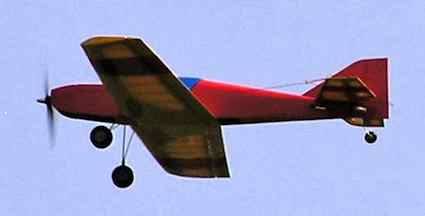
Fusion 380 inflight with 72MHz system
Return to the article
Return to "What's In This Issue"
Detroit Aero Modelers Upcoming E-Meet
AMA Sanctioned 2013 Electric Fun Fly
Saturday, July 27
9 a.m. to 4 p.m.
Alex Jefferson Field in River Rouge Park
At the corner of Joy Road and Spinoza
Open event for all electric aircraft & helicopters
NO LANDING FEE! Just come out and have fun!
The grill will be available for use for all pilots.
Spectators watch for free and are always welcome.
Contest Director: Arden McConnell 313-274-3185
Web site: www.detroitaeromodelers.com
Return to "What's In This Issue"
Don Belfort's New Ercoupe
From Don Belfort via email
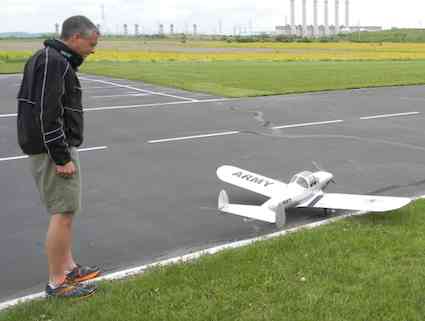
Don with his new plane
Hi Ken,
All went well for the Ercoupe's maiden flight. It only needed a few clicks of up elevator. The grey skies prevented flight shots, but I'm hoping for good weather at Mid-Am.
See you soon,
Don
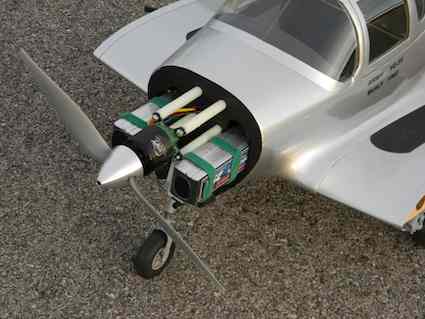
Inside the cowl
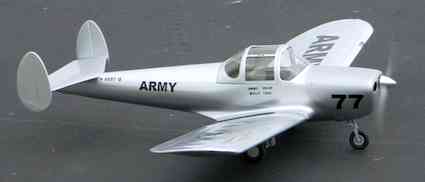
Taking off
Return to "What's In This Issue"
Tips for Preventing Voltage Droop
From Roger Klingbeil via email
Ken,
I saw this article.
As an EE, this was a review of what I do without thinking. See the voltage droop comparison. The twisting norm used to be 3 turns per inch.
Return to "What's In This Issue"
Announcing the 29th Annual Mid-America Electric Flies
Here are the links to the 2013 Flyer as well as the field map and local area hotels list.
2013 Flyer
2013 Map to the flying field and local hotels listing
Return to "What's In This Issue"
| 








